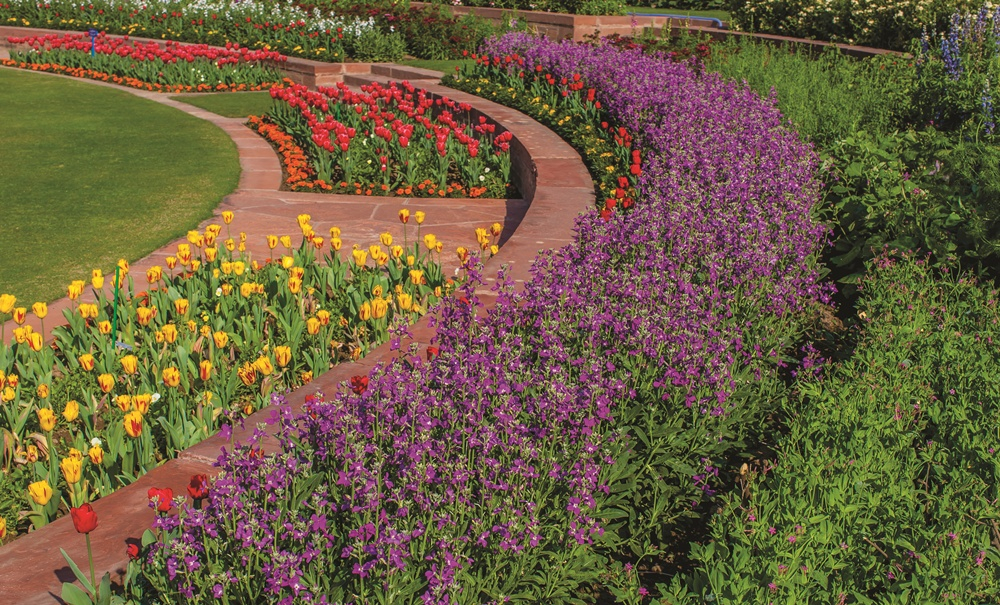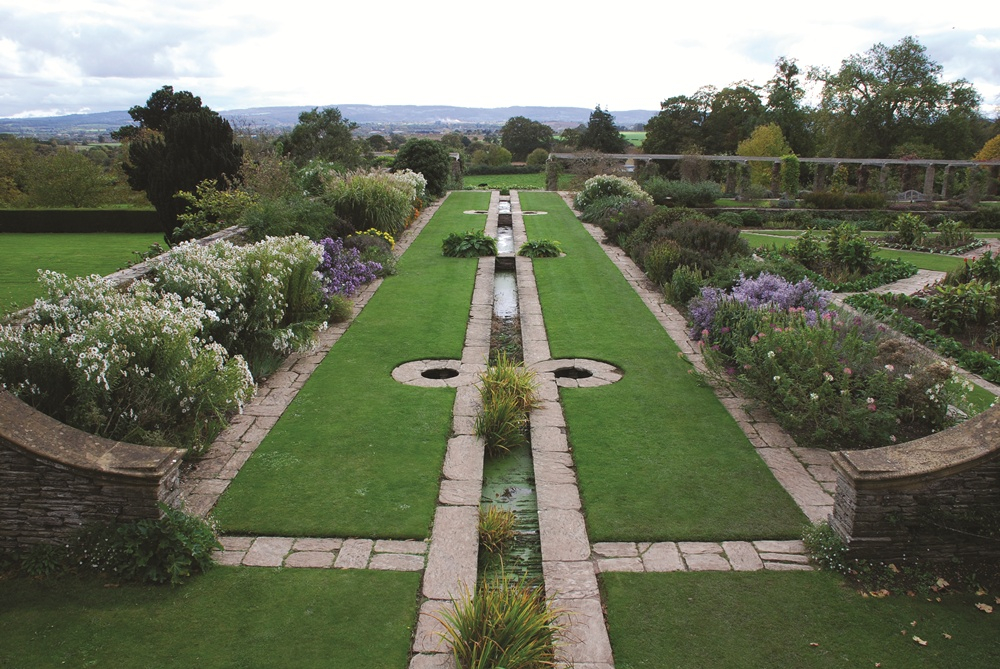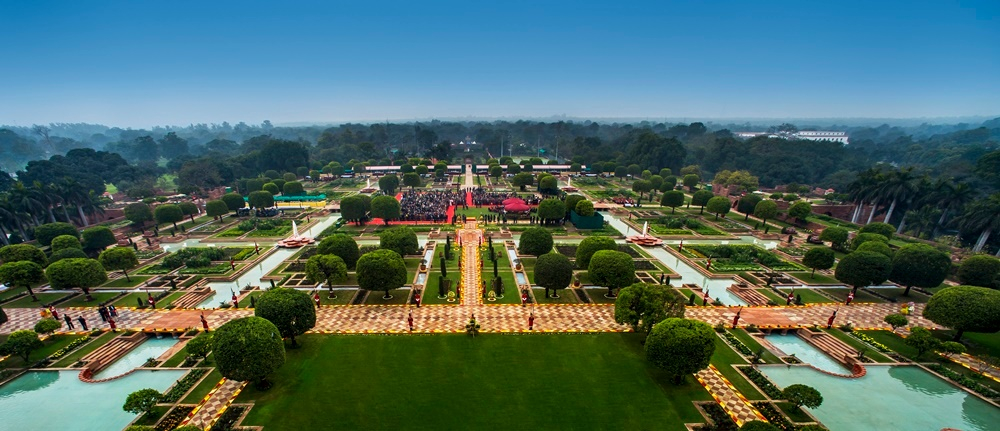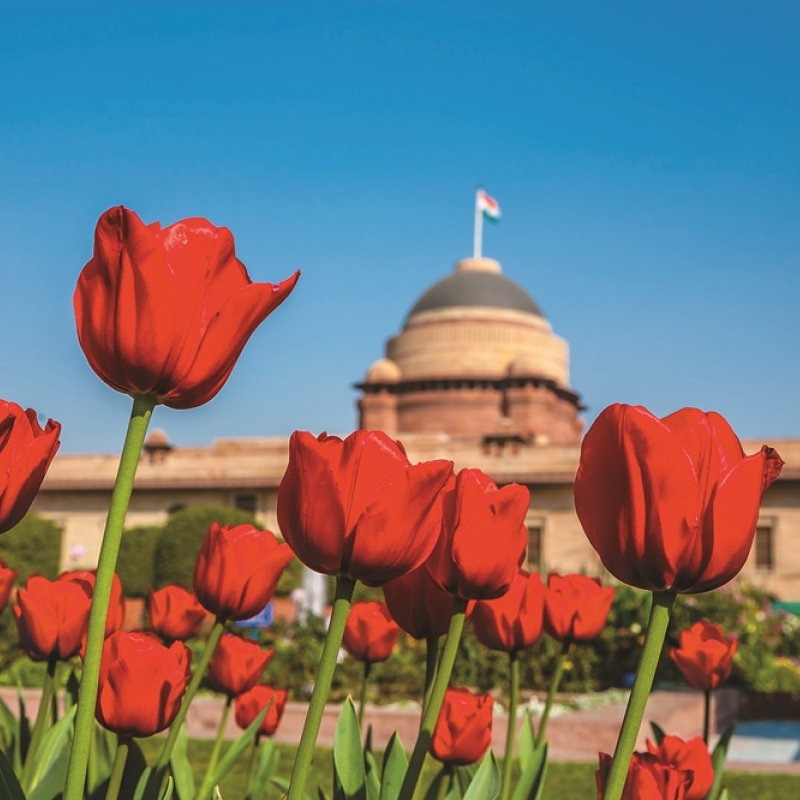Thousands visit the beautiful Mughal Gardens at the Rashtrapati Bhavan during February–March every year. But what we skim over is the fact that the 15-acre garden has, almost since independence, played the role of a state garden. Using edited excerpts from Amita Baviskar’s introduction to the book, First Garden of the Republic, we see how our presidents have used the gardens as much for diplomacy as for ‘public service by example’. (Photo courtesy: Narendra Bisht/Sahapedia.org)
‘With great power comes great responsibility.’ One may not expect gardens to assume such responsibility, but with the right kind of leadership, even they have a role in public service. This is specifically true of the ‘First Garden’ of India, better known as the Mughal Gardens of the Rashtrapati Bhavan.

In February–March every year, the Mughal Gardens burst into a riot of colour. The 15-acre grove that boasts of 70 varieties of flowers, almost 50 varieties of trees, shrubs and vines, lush greenery and lavish water fountains is thrown open to the public for the month-long Udyanotsav, or garden festival. While thousands throng to it taking in its beauty and splendour, it is easy to appreciate the role played by the Mughal Gardens as a ‘state garden’ practically since independence. Not only has it hosted hundreds of heads of state and international dignitaries, but it has also changed to show solidarity with the public and make a statement. The most notable expression of this democratic impulse was the opening up of the gardens in the 1940s, when the estate was still home to the Viceroy. During World War II, it was decided to open the formal gardens to the public in February and March, when the flowers were at their best. The Udyanotsav, or Garden Festival, has been an annual ritual ever since.

The Majestic Garden
The Mughal Gardens were designed by Sir Edwin Lutyens, in collaboration with William R. Mustoe, then Delhi’s Superintendent of Horticulture Operations, in the 1920s and 1930s as part of the Viceroy’s Estate, a 330-acre property with a house over 5 acres, as a stellar example of flora, fauna and design. They are inspired by the Mughal gardens in Jammu and Kashmir, the gardens around the Taj Mahal, and miniature paintings of India and Persia. Divided into three key sections—the Rectangular Garden, the Long Garden, and the Circular Garden—the Mughal Gardens incorporate two very different horticultural traditions. These are: the Mughal charbagh (quadrilateral layout based on the four gardens of Paradise mentioned in the Quran), and the English flower garden, where the Mughal-style canals, terraces and flowering shrubs are brought together with the caprice of European flowerbeds, lawns and private hedges. Though the initial designs of the lush gardens were finalised in 1917, the plantings were carried out in 1928–29, two years before the Viceroy, Lord Irwin, moved in.
More interesting, though, is the story of why, from 1948 to 1962, a section was used to grow wheat, one of India’s staple foods.

The People’s Garden
Within a year of India gaining independence, historian and statesman C. Rajagopalachari took over as the Governor-General of India from Lord Mountbatten. Known to be a simple man and a Gandhian, he was initially reluctant to live at the 330-acre property, which was representative of the legacy of the colonisers. A quirky example of its luxury is represented in the fact that of the 418-member garden staff under the British, 50 were seemingly employed just ‘to scare off crop-raiding birds and 20 to make flower arrangements’. However, India’s then prime minister Jawahar Lal Nehru persuaded him to reconsider, and he eventually shifted into ‘a modest apartment in the north wing of the estate’.
Yet, for Rajagopalachari, the Rashtrapati Bhavan and the pleasure garden was the ultimate form of conspicuous consumption while India was reeling from the consequences of centuries of plundering and building itself ground up, writes Amita Baviskar in the introduction to the book First Garden of the Republic. Thus, in solidarity with his fellow countrymen and as a symbolic gesture to address the food shortage facing Indians, Rajaji used a section of the gardens to grow wheat. However, it wasn’t only Rajaji who wanted to turn the Rashtrapati Bhavan into a self-sustainable entity. In a letter to Lord Mountbatten in 1948, Nehru had suggested that ‘part of the estate be given over to market gardening to cover the high labour cost of maintaining the gardens’. Indeed, this practice of growing wheat was continued by Rajaji’s successor and the first president of India, Rajendra Prasad, during his tenure (1952–62).

First Among Equals
Since then, various presidents have used the gardens as models of self-sustainability and innovation. ‘More recently, the changing needs of small farmers led the Estate to experiment with planting trees that can be used as bio-fuels and to start a small unit for oil pressing, juice extraction and processing medicinal plants. With growing ecological consciousness have come initiatives to conserve water. In 1998, at K.R. Narayanan’s request, the Centre for Science and Environment installed a system to capture rainwater for recharging groundwater on the Estate.
‘In 2015, Pranab Mukherjee inaugurated a sewage treatment plant to supply recycled water for gardening while also filling up a reservoir to attract wetland birds. Pratibha Devisingh Patil started Roshni, a project to make the Estate a model for urban ecological sustainability, in 2008. During her tenure, the Estate received ISO 14001:2004 certification for its solar lighting, vermicomposting, waste segregation and water harvesting.’
Also Read | Colonial and Modern Art at the Rashtrapati Bhavan
Such additions to the Mughal Gardens were a reflection of the times as also of the personality of the respective heads of state. Abdul Kalam, after becoming president in 2002, converted the lawns facing North Avenue and adjoining the formal gardens into herb gardens displaying indigenous plants used in Ayurvedic and Unani medicine. ‘Another section of the lawn was enclosed as a menagerie with spotted deer, rabbits and geese, next to a set of musical fountains in which jets of water play on time to patriotic tunes. Besides education and amusement, Abdul Kalam aimed at a more profound message in planting the Spiritual Garden, bringing together trees associated with different religious traditions in the country. As Ram Singh, a gardener who worked to create the grove, remarked, “If 40 types of trees and shrubs can live together in harmony, then why not us humans?”’
Given the socio-political atmosphere in India over the past two decades, this ideology seems most befitting a state garden.
159 Varieties of RosesIn Christopher Hussey’s The Life of Sir Edwin Lutyens (1950), Lutyens’ wife, Lady Emily Bulwer-Lytton praised the beauty of the Mughal Gardens and wrote that the ‘flowers are set in such masses, producing a riot of colour and scents that, with the fountains playing continually, there is not the least sense of stiffness. The round garden beyond beats everything for sheer beauty and is beyond words’.
Roses were Mustoe’s speciality. The gardens of the erstwhile Viceroy’s residence contain more than 159 varieties of rose, including those named after famous Indian figures such as Mother Teresa, Raja Ram Mohan Roy and Pandit Jawahar Lal Nehru, along with two Pandavas, Arjun and Bhim, from the Mahabharata. The presidential garden offers more than 70 varieties of seasonal flowers apart from roses, including tulips, lilies, hyacinth, and daffodils, and almost 50 varieties of trees, shrubs and vines. All of this is maintained by about 300 gardeners.
This article was also published on Firstpost.












